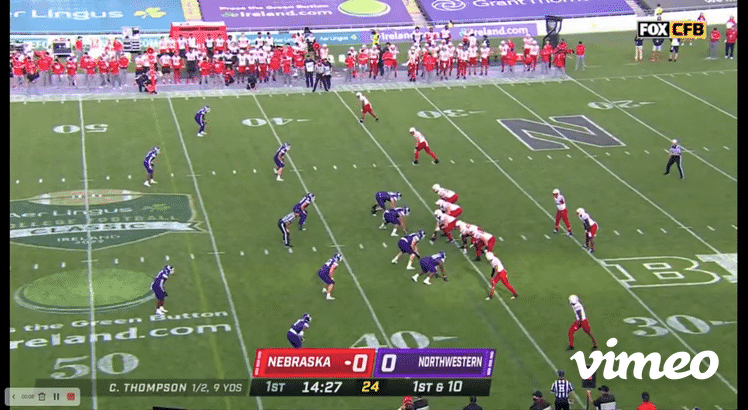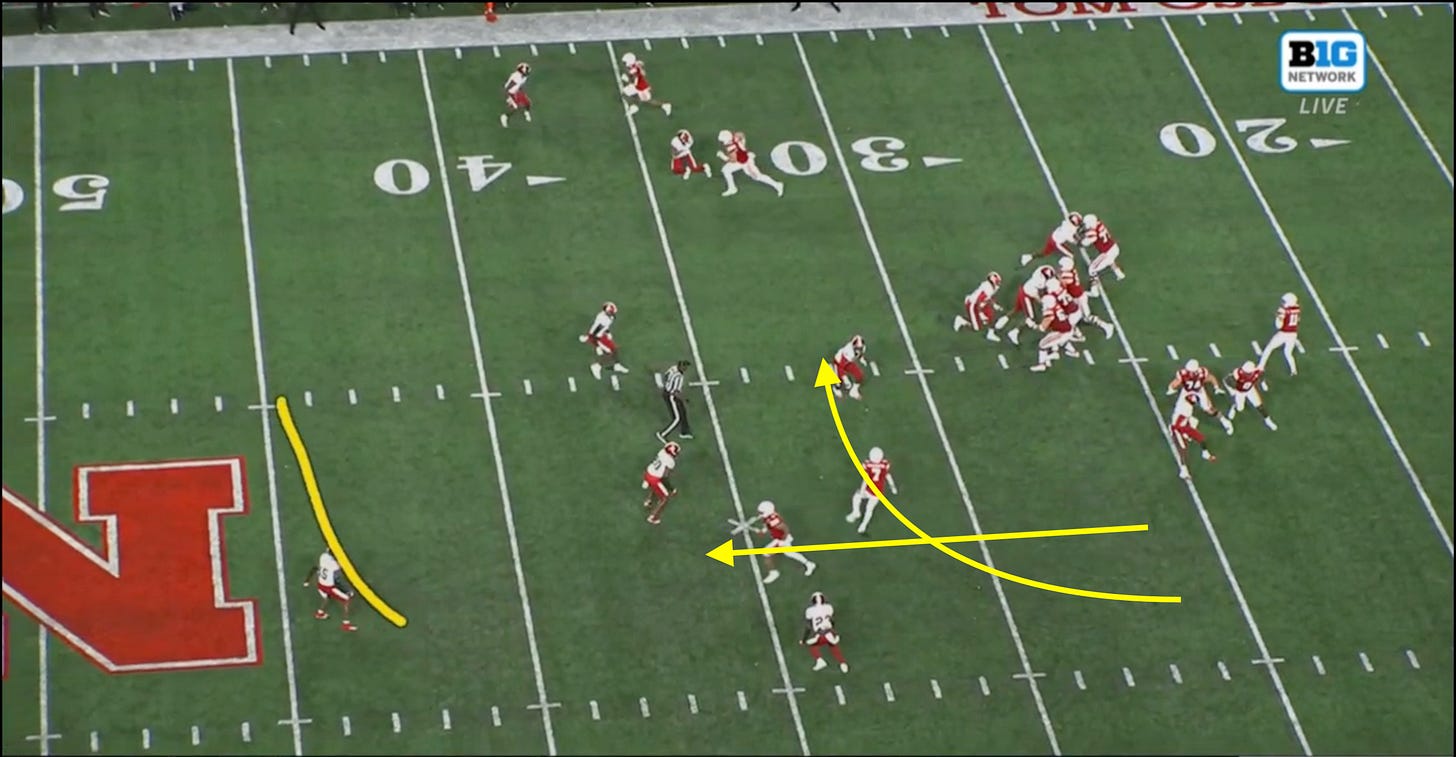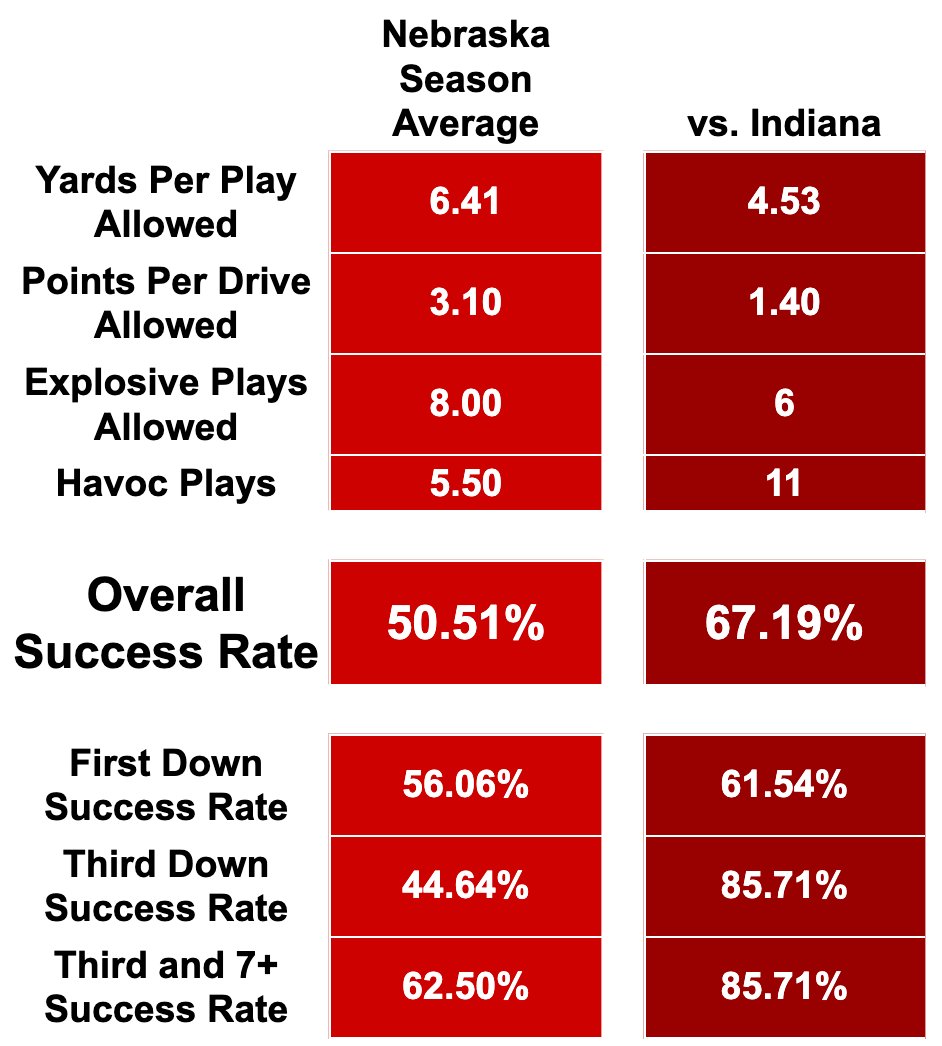INDIANA RECAP: Let's Get Aggressive
After getting torched in the first four games, the Blackshirts institute some major changes — but will they hold up?
A WIN!! It’s been a brutal season to date, and it very likely will continue to be one, but that was genuinely a fun, good game and moment to enjoy. Memorial was rocking; big, exciting plays were happening; and the players were into. Scenes like that have been few and far between for fans to enjoy the last few years, and it has to be even more rewarding and cathartic for the players and coaches who have been throwing the work and hours into this thing with little reward. And seeing Mickey get a win ROCKED.
PROGRAMMING NOTE: If you were tuned out for the offseason or are a new subscriber, I would suggest reading the post detailing the newsletter’s plan for this year; it will better explain things like success rate.
OFFENSE
GAME CHART
2022 Indiana Offensive Game Chart
OVERALL
The late 71-yard touchdown pass saved what was otherwise a pretty meh offensive performance from NU. Some of the poor number here are due to penalties getting the offense behind the sticks — it’s harder to be “successful” on 3rd and 25 because of a personal foul than it is to be “successful” on 3rd and 5 — but from the eye test it also was just a disjointed night. Tom Allen is a great defensive mind, but this is not a vintage Tom Allen unit: The Hoosiers defense entered this game ranked 72nd in Defensive SP+, only a few spots ahead of the Blackshirts. Nebraska’s offense looked great out of the gates this year, was destroyed by OU, and has now struggled against a pretty mid/bad unit. It seems as if the surprise element of Mark Whipple’s new scheme has worn off and the predictability/basicness of what he’s running is starting to catch up with NU.
One of the things new coach Mickey Joseph said he wanted to do after the loss to OU was to slow Nebraska’s offensive tempo down to protect its defense. That did happen Saturday, with NU’s fast tempo rate dropping nearly 20 percent from its season average. This creates a different issue, though: Operating at fast tempo was a real weapon for Nebraska, with season-long success rate at fast tempo 30 percentage points higher than operating at no tempo and 40 percentage points higher than moving at slow or “check-with-me” tempo. While there is some noise to the “fast tempo” success rate (when your offense is moving well you want to push down the accelerator on the pace), it’s pretty obvious that NU’s offense is worse when it gives defenses time to communicate, organize, and prepare. I’ve talked in past posts about Whipple’s offense being siloed and predictable, and slower or no tempo allows defensive coordinators to have the time to remind their guys of NU’s very obvious pre-snap tendencies or to get into designer pressures (like OU did in Game 4). Moving slower may help the defense, but it’s hurting the offense.
RUNNING GAME
Indiana’s general defensive gameplan Saturday was to stack the box to stop NU’s running game and then bring heavy pressure/run creative coverage disguises to disrupt obvious passing downs. The Hoosiers presented a heavy box against NU on 65% of their plays — 20 percentage points higher than NU has seen in any game this year.
Since Whipple became the sole offensive designer over the last two weeks, NU has seen a dramatic rise in its usage of Outside Zone — the first three games of the season saw just five plays with an Outside Zone element, and the last two have had 14. Whipple prefers zone runs, with some Duo mixed in against heavier boxes, and a few Counters or a Traps situationally. Outside Zone was a big part of his package at Pitt when I broke down their film, so I think the increase shows we’re seeing the full Whipple-ization of the offense; all the elements Scott Frost had tacked on are gone. Further supporting this is that NU has run just one play with a Triple Option element since Whipple took over, after it was at least a tangible part of the running game in the first three games.
This also creates a problem because Nebraska has been much better at gap-scheme runs — which were probably Frost influences — this season (“Gap scheme” is a run that has linemen blocking specific, predetermined defenders and the back hitting a specific hole; zone schemes ask linemen to block space and are more free-flowing for the back). Spamming more zone may be more comfortable for Whipple, but it’s probably not what’s best for Nebraska’s offense.
It’s also worth noting that Whipple wants to primarily operate in 11 Personnel and use the run as a punishment/deterrent to light boxes and not really as a focal point of the offense. But Nebraska has actually been a much better running team out of heavier offensive personnels and against heavier defensive looks — Running out of 12 Personnel may be the best thing this offense does.
PASSING GAME
Indiana brought a lot of heat Saturday — IU ran some sort of pressure on 60% of NU’s pure passing plays — and ran a lot of disguised looks in its secondary. This is the second straight game this has been used against Nebraska (after Northwestern, North Dakota, and Georgia Southern basically brought no pressure and played basic), probably because quarterback Casey Thompson has shown a very real drop in play when the blitzing and disguising has been turned up. On reps where he wasn’t blitzed, Thompson had a 70 percent success rate on pure passing plays Saturday … and a 35% rate when IU was running a pressure. That makes some obvious sense — it’s harder to operate when you’re rushed or have guys sprinting at you or the defense is doing something tricky — but good quarterbacks WELCOME the blitz because it allows them to gash a compromised defensive secondary. Some of this is on an offensive line that is not very good struggling to protect, but Thompson needs to also start hurting teams when they bring pressure if he wants them to stop doing it.
NU’s heavier protections were up Saturday, but that was largely a function of Nebraska’s back staying in to protect on check-and-release more often with Indiana’s high pressure rate.
Take my route concept breakdown with a grain of salt this week; I hate the Big Ten Network games because they zoom in on just the tackle box and I can barely see anything happening downfield. If I didn’t get a wider replay, most of these were just educated guesses from the stem and what NU has run previously. One thing that did happen Saturday was an increase in Smash concepts (a short Hitch or In route by an outside receiver and a Corner route by the inside receiver) to take advantage of the sideline hole against the Cover 2 IU was using a lot.
Now, LET’S TALK ABOUT THE TOUCHDOWN:
A COOL PLAY
One of NU’s most-utilized passing plays this season has been a Drive concept out of an open doubles look with short pre-snap motion. I talked a bit about it in the post breaking down the Northwestern game.
NU has run this play 13 times in the last three games, more than any other specific passing concept I’ve seen. It’s high on the scouting report of any defense playing Nebraska. The long TD on Saturday essentially took advantage of that.
The play starts looking like the Drive concept. Marcus Washington, the outside receiver, does the short glide motion that has been a dead giveaway in the past Drive was coming.
Indiana begins in a two-high safety look pre-snap, likely indicating Cover 4, but rotates the field safety into the box after the snap, revealing the coverage to be Cover 3. Both Thompson and Trey Palmer, who appears to be running the 10- to 12-yard in-breaking “Basic” route, start the stems of his route as if the Drive concept is coming:
The outside corner closest to the bottom of the picture, who normally would be responsible for the deep outer third of the field closest to the screen, expects Palmer to break inside, so he passes him off and looks for other receivers. It’s probably been drilled into his head every day in practice this week to look for the Drive in this alignment. But that’s not what is about to happen:
Instead of breaking inside as he normally would, Palmer gives a step fake to the inside before cutting back out at an angle toward the corner of the field. That cornerback responsible for that area (still expecting the inside break) isn’t even looking at Palmer at that point. Additionally, Washington has pivoted out of his underneath drag route and is racing back to the sideline and into the cornerback’s area of coverage, pulling his eyes away from what Palmer is doing behind him. Look at his head positioning and eyes in the screenshot above.
That leaves the deep middle safety as the only player even looking at Palmer — and he’s too far in his own coverage area to be able to recover and get over the top of Palmer to bail out his teammate’s mistake. The line gives Thompson enough time against the four-man rush, and Thompson — not a particularly strong-armed quarterback — throws a great deep ball to the sideline away from the safety. … *CHEF’S KISS* … Here’s what it looks like at full speed:
The poor bottom corner is in the torture chamber. NU previously tried to run this against OU on a third down, but it got blown up. This was a great design by Whipple, and it won the game. Sometimes being predictable can be used for your own gain!
DEFENSE
GAME CHART
2022 Indiana Defensive Game Chart
OVERALL
After refusing to deviate from a bland, big-play-prevention defense that couldn’t stop short gains and never disguised its intention to the offense, coordinator Erik Chinander was fired as defensive coordinator after the OU game. Bill Busch, brought in this offseason to fix the special teams, found himself now in charge of trying to fix — or at least stabilize — what looked to be one of the worst groups of Blackshirts in years. Rough job! With a full bye week to make changes, I was excited to see what, if anything, Busch might do to improve things. It’s tough to “fix” a bad defense, especially when so much of NU’s problems this year have been personnel based, so I figured this would largely be rearranging the deck chairs with some minor shifts.
But my man went out and COMPLETELY 180’D THE DEFENSIVE STRATEGY.
After prioritizing deep-field-zone, big-play-prevention coverages like Cover 3 and Cover 4 for five years under Chinander, Nebraska on Saturday came out and ran Cover 1 — an aggressive, man-on-man coverage that leaves corners on an island with only one player deep to provide help to the entire field — on 67% OF ITS SNAPS. Nebraska’s previous high in Cover 1 usage had been around 40% against Georgia Southern and Oklahoma as Chinander flailed desperately for an answer. The Blackshirts also utilized much more aggressive press techniques at the line than it had in its Cover 3 and 4-based system. NU did this while inserting a low-ranked, 5’9 true freshman into its lineup as a starting corner and and asking him to play press with little help for most of the night.
This was a tremendous philosophical shift — akin to an Air Raid team switching to Wisconsin’s offense in one week — and also tremendously risky. Cover 1 is incredibly vulnerable to big plays; if one cover player loses their matchup to a receiver, it’s probably a touchdown or chunk gain, and Nebraska’s less-than-stellar pass rush means the coverage has to hold up longer into the play. Add on that the high use press coverage raises the chances someone gets beat. What happened Saturday was a massive, massive gamble.
But I don’t know if it was a bad gamble. A good quarterback and crew of receivers will be able to torch what Nebraska rolled out Saturday, but how many scary quarterbacks and receiver corps are left on the schedule? Michigan and Purdue have good passing attacks that are likely to shred this, but beyond them, the QBRs of the passers on NU’s remaining schedule are: 66.2 (Tanner Morgan), 63.8 (Tommy DeVito), 50.4 (Graham Mertz), 48.2 (Evan Simon), and 17.8 (Spencer Petras). Not exactly terror inducing! One or several of those teams will still likely be able to connect on some of the passes Indiana wasn’t able to and really burn this, but if you’re forced to choose between (a) NU continuing it’s strategy of slow death under Chinander’s style, or (b) getting aggressive and trying to punch back a bit, I think I’m much more down with the latter option.
Furthermore, we’ve seen a shift to a Cover 1, aggressive style work out for bad defenses before. On NU’s schedule last year alone, Michigan State, Minnesota, Purdue, and Illinois all entered the 2021 offseason with poor defensive play, then switched to Cover 1-heavy schemes in the offseason and saw their efficiency rankings skyrocket last season. This style is essentially a bet that college quarterbacks and receiver combos aren’t consistently good enough to make you pay for aggressive play in the secondary. Sometimes, that backfires — think Michigan State’s game vs. Ohio State last year — but more often in recent years, it seems like it’s been proven correct.
One other change I noticed Saturday was not only an increase in Bear fronts from NU but a change in how they were constructed. Previously, NU has only run Bear — a five-down defensive line — with its 3-4 personnel — a nose tackle (Nash Hutmacher) and two defensive ends (Ty Robinson and Colton Fiest), plus two edge players (Garrett Nelson and Ochaun Mathis).
On Saturday, NU eschewed the nose tackle, instead moving one of the ends inside to play nose guard, taking one of its edge players to defensive end to replace, and then moving one of it’s Mike linebacker or Nickel in the spot of the edge.
The five down linemen in a Bear front are lined up, more or less, directly across from each offensive lineman. NU played more Bear on Saturday overall than it has in any game this season, and it makes sense — a Bear front makes each defensive lineman responsible for one gap, as the NU d-line’s inability to play a gap-and-a-half or two-gap technique had one of NU’s biggest issues in causing the defensive collapse. NU saw its combined use Saturday of Even front (four down linemen, called Under or Over fronts based on the positioning of the 3 technique) drop from around 66% in previous games to around 42% Saturday as it played more Odd and Bear.
Playing five guys on the line instead of four necessarily takes someone out of coverage, and NU compensated for this by not playing its Cover 1 with a “Robber” (a short field zone player who can help freelance and close throwing lanes onto shorter routes) as it typically is. Nebraska was simply playing five guys on the line, five guys locked on the eligible receivers playing tight to the line of scrimmage, and one guy deep … for most of the game. Here’s a diagram I did of it last year in preparation for last season’s Illinois game that essentially shows what NU’s plan Saturday was:
I would be surprised if the defense played this well again. It was a pretty fortunate performance from a third-down perspective, Indiana’s offense was not the unit to take advantage of Nebraska’s aggressiveness, and the element of surprise is gone and teams will enter games prepared for this. It will get worse. But this is not a good team — or a good unit — and if it’s going out, I’d rather it go out swinging than getting slowly bled to death.
Thanks, as always, for reading! Comments are open below, and I apologize if I didn’t get to any last week; I’ll attempt to work through them shortly! GBR.

















